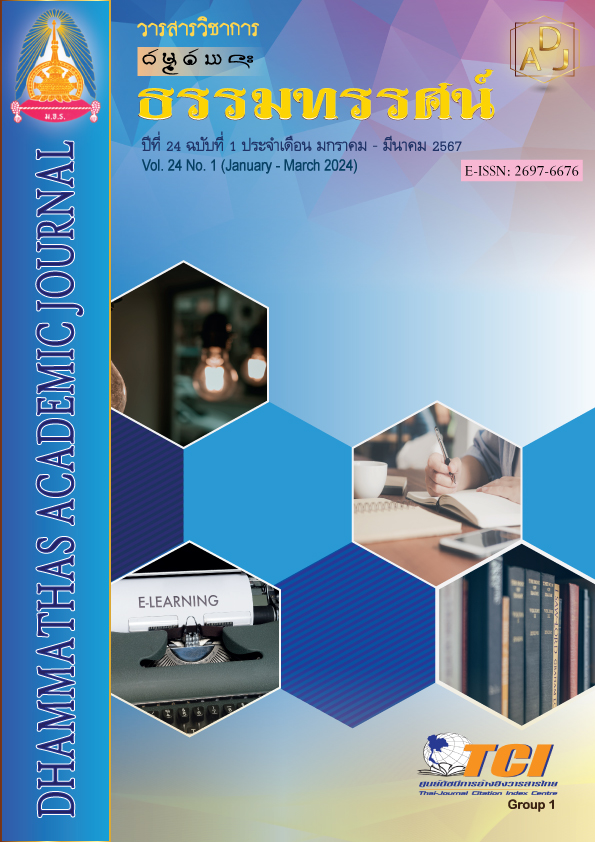The Area-Based Development of Phra Bundit Asa and Phra Dhammacarika for Solutions of Poverty of the Highland People
Main Article Content
Abstract
The aims of this research encompass several key objectives: 1) Investigate the contextual factors, prevailing conditions, challenges, barriers, and requirements essential for the progress of highland regions. 2) Examine the roles, responsibilities, mandates, and operational parameters of Phra Bundit Asa and Phra Dhammacarika in highland areas. 3) Explore the fundamental principles of community development in highland regions and devise innovative community solutions rooted in Buddhist principles to address poverty among highland inhabitants. 4) Propose a spatial development model integrating Buddhist innovations from Phra Bandit Asa and Phra Dhammacarika tailored for highland contexts. This research employs a blend of qualitative methods and participatory action research across three community research sites: Ban Dok Daeng, Ban Huai Bong, and Ban Chan, engaging with a cohort of 25 key informants. Methodological tools include spatial surveys, in-depth interview protocols, and before-after activity assessments, with data analyzed and findings summarized descriptively.
The research findings reveal the following insights:
1. Context: The highland populace exhibits a diverse social landscape encompassing factors such as ethnicity, religion, education, debt, income, and occupation. Despite this diversity, the issue of poverty persists without tangible resolution. Insufficient income to cover expenses and mounting debts compound their challenges. Geographical constraints, resource scarcity, and limited access to services and information exacerbate their predicament. Addressing these challenges necessitates a focus on local economic promotion and the development of agriculture and industries suited to the environment.
2. Roles, duties, missions, and performance conditions of Phra Budit Asa and Phra Dhammacarika involve various facets: 1) Propagation of Buddhism. 2) Cultivation of mental well-being. 3) Preservation of arts and culture. 4) Advocacy for watershed forest conservation. 5) Dissemination of knowledge on the dangers of drug abuse.
3. Principles of highland community development and community innovation, rooted in Buddhist principles such as tiṭṭhadhammikattha or virtues conducive tobenefits in the present, emphasize: - Fostering a millionaire's mindset to address poverty. - Prioritizing self-reliance. - Advocating for the conservation of natural resources. - Leveraging temples as hubs for local wisdom dissemination. - Encouraging community involvement and participation.
4. Proposed model for spatial development integrating Buddhist innovations includes: 1) Empowering self-reliance among communities. 2) Advocating for the conservation of natural resources. 3) Leveraging temples as educational centers for local wisdom. 4) Facilitating active community participation in development initiatives.
Article Details

This work is licensed under a Creative Commons Attribution-NonCommercial-NoDerivatives 4.0 International License.
เพื่อให้เป็นไปตามกฎหมายลิขสิทธิ์ ผู้นิพนธ์ทุกท่านต้องลงลายมือชื่อในแบบฟอร์มใบมอบลิขสิทธิ์บทความ ให้แก่วารสารฯ พร้อมกับบทความต้นฉบับที่ได้แก้ไขครั้งสุดท้าย นอกจากนี้ ผู้นิพนธ์ทุกท่านต้องยืนยันว่าบทความ ต้นฉบับที่ส่งมาตีพิมพ์นั้น ได้ส่งมาตีพิมพ์เฉพาะในวารสาร วิชาการธรรม ทรรศน์ เพียงแห่งเดียวเท่านั้น หากมีการใช้ ภาพหรือตารางของผู้นิพนธ์อื่นที่ปรากฏในสิ่งตีพิมพ์อื่นมาแล้ว ผู้นิพนธ์ต้องขออนุญาตเจ้าของลิขสิทธิ์ก่อน พร้อมทั้ง แสดงหนังสือที่ได้รับการยินยอมต่อบรรณาธิการ ก่อนที่บทความจะได้รับการตีพิมพ์References
กรณิศ ดวงใบ. (2559). การแก้ไขปัญหาความยากจนด้วยพุทธบูรณาการ. วารสารสวนปรุง, 32(2), 43-44.
ทาริตา แตงเส็ง, ณัฐวิภา ทองรุ่ง และกัมปนาท วงษ์วัฒนพงษ์. (2563). การพัฒนาชุมชนตามแนววิถีพุทธ. Journal of Modern Learning Development, 5(4), 239-253.
บุญชม ศรีสะอาด. (2545). การวิจัยเบื้องต้น. (พิมพ์ครั้งที่ 7). กรุงเทพฯ: สุวีริยาสาส์น.
พระอุดมบัณฑิต (สมศักดิ์ สุทฺธิญาณเมธี). (2562). พระธรรมจาริก: กระบวนการ และรูปแบบ การเผยแผ่พระพุทธศาสนาบนพื้นที่สูง อาศรมพระธรรมจาริกบ้านเข็กน้อย จังหวัดเพชรบูรณ์. (วิทยานิพนธ์พุทธศาสตรมหาบัณฑิต). พระนครศรีอยุธยา: มหาวิทยาลัยมหาจุฬาลงกรณราชวิทยาลัย.
มหาจุฬาลงกรณราชวิทยาลัย. (2539). พระไตรปิฎกภาษาไทย ฉบับมหาจุฬาลงกรณราชวิทยาลัย. กรุงเทพฯ: มหาจุฬาลงกรณราชวิทยาลัย.
สถาบันวิจัยและพัฒนาพื้นที่สูง (องค์การมหาชน). (2562). แผนการวิจัยและพัฒนาพื้นที่สูงระยะที่ 8 ปี (พ.ศ. 2563-2570). กรุงเทพฯ: สถาบันวิจัยและพัฒนาพื้นที่สูง (องค์การมหาชน).
สำนักงานคณะกรรมการส่งเสริมวิทยาศาสตร์ วิจัยและนวัตกรรม (สกสว). (2564). กลุ่มชาติพันธุ์ในประเทศไทย: งานวิจัยและความท้าทาย. (รายงานการวิจัย). กรุงเทพฯ: สำนักงานคณะกรรมการวิจัยแห่งชาติ.
Hawkins, D. I., Best, R. J., & Coney, K. A. (1998). Consumer behaviors: Building marketing strategy. (7th ed.). MA: McGraw-Hill.

